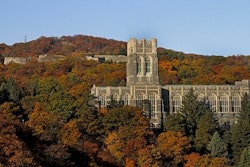Despite the gains minorities have made in student enrollment and higher education leadership, the needle needs to move further and faster in the next 25 years to narrow the widening educational achievement equity gap.
When 22-year-old Roberto Rosas was awarded his bachelor’s in electrical engineering this spring from the University of Texas at San Antonio, it marked a major milestone for his family.L
Like a growing number of students of color, Rosas is the first person in his family to graduate from college, a feat he achieved based on sheer determination to better himself and the lives of those around him.
“My family was just in shock,” Rosas says. They didn’t think it was possible for anyone in our family to go to college.” He says he received “no inspiration or motivation” from his high school teachers and counselors, although he was in the top 10 percent of his high school graduating class. “I wanted to do something better.”
The experiences of Rosas help put a real face on myriad reports that show a steady increase in the number of minorities earning college degrees in the United States over the past 25 years. Degrees earned, one measure of academic achievement and increasingly a required ticket for getting a well-paying job in this country, are up in all ethnic groups, according to the National Center for Educational Statistics (NCES) and a more narrowly focused report released this spring by the National Association for Equal Opportunity in Higher Education.
Substantive Gains
For the 2006-2007 academic year, the latest figures available from NCES, Blacks earned 9.6 percent of all bachelor’s degrees awarded, Hispanics 7.5 percent, Asians 6.9 percent and American Indians 0.8 percent. Whites earned 72.2 percent of all bachelor’s degrees awarded and foreign students 3 percent. For 1984-1985, the corresponding numbers were 6.1 percent, 2.8 percent, 3.4 percent and 0.4 percent. For Whites, in 1984-1985, the corresponding numbers were 88 percent. There was no calculation for foreign students.
Racial minorities also showed gains in earning doctorate degrees, the credentials needed to hold professorial and top executive jobs in academic management and policy making such as president, chancellor and provost. For the 2006-2007 academic year, Blacks earned 6.1 percent of all doctorates awarded, Hispanics 3.4 percent, Asians 5.8 percent and American Indians 0.4 percent. Whites earned 56.2 percent of all doctorates awarded, while foreign students studying in the United States earned 28 percent. For 1984-1985, the corresponding numbers were 3.6 percent for Blacks, 2.1 percent for Hispanics, 3.2 percent for Asians and 0.3 percent for American Indians. For Whites, in 1984-1985, the corresponding numbers were 74.1 percent. Foreign students studying in America earned 19.4 pecent of all doctorates awarded that year. The numbers are just as impressive for degrees earned at the master’s level.
The numerical gains in degrees earned over the past 25 years are just one sign of minority achievements in higher education over the past 25 years, say demographers and academics interviewed across the country. Signs of progress are all over the academic landscape. In leadership, more people of color have been appointed to top executive roles and at a wider range of colleges. Also, while their numbers are finite, Hispanics and Asians are being appointed leaders of colleges, just as Blacks and American Indians have headed institutions of higher learning for decades.
In the important arena of accreditation, there has been a steadily increasing presence of minorities in the ranks of accrediting organizations and participation on peer review panels.
“They understand what our people go through,” says Dr. Mildred García, president for the past two years of California State University, Dominguez Hills. García, the first Hispanic appointed president of a Cal State System school, says the presence of people of color on accrediting panels gives those bodies greater insight into the challenges faced by schools with large minority populations. “They understand these are not excuses, these are realities,” says García, who has served on the Middle States Commission on Higher Education accrediting panels.
Also, in the accrediting arena, people cite other key changes such as the appointment of Virginia educator Dr. Belle Wheelan as head of the Commission on Colleges of the powerful Southern Association of Colleges and Schools (SACS).
In the area of academic research about academia, more minorities have become involved with the Association for the Study of Higher Education. They are writing papers that add to the body of knowledge on how to improve the ability of institutions to attract and retain more students of color.
For Hispanics, in particular, the passage by Congress in 1992 of legislation officially recognizing Hispanic-serving Institutions (HSIs) paved the way for major initiatives to help these nearly 275 schools (most of them two-year institutions) to help educate more Hispanic students. In subsequent years, HSIs have built on that achievement, getting additional legislation passed including a 2008 Farm Bill amendment that expanded agriculture programs at four-year HSIs to mirror those of the traditional h i s tor i c a l l y White and Black land-grant colleges.
Falling Behind
The excitement over these achievements is tempered by a more sobering reality, say those interviewed: Despite all the gains, minorities are falling further and further behind in closing the higher education equity gap between people of color and non-minorities.
“Minorities have made striking gains but are falling short of what’s needed,” says Dr. Roderick Harrison, demographics consultant at the Washington-based Joint Center on Political and Economic Studies. “If you just look at the numbers, you would see steady increases for two reasons. The minority population is growing, especially among Hispanics, and the White population is declining as a percent of the whole population.”
Also, the significant percentage gains for Blacks and Hispanics stem from a very small base. In 1969, for example, only 5 percent of all African-Americans had a college degree, says Harrison.
Harrison, the former chief of racial demographics for the U.S. Census Bureau and a sociologist at Howard University, says a more critical look at academic statistics yields some troubling indicators.
The degrees earned ratio between Blacks and Whites and Hispanics and Whites actually widened between 1984 and 2008, based on census data, Harrison found. That means Blacks and Hispanics are capturing a smaller share of degrees awarded today when compared to Whites than was the case a quarter century ago, he says.
There are other troubling signs. Studies show significant increases in the number of minority students going to college over the past 25 years but far fewer graduating, especially Black men.
Too many minority students still come to college academically deficient to perform college work, says Wheelan of the SACS. “Affordability” also remains a crucial issue, she adds, explaining that “funding and ability to pay are still an issue” for Blacks and Hispanics.
In academic leadership roles, others note the growth in percentage and numbers of minorities holding top positions at colleges and universities has slowed significantly after big gains earlier. Women overall have made significant gains in leadership, observers say, but the share of power by minorities overall has not changed appreciably.
“You can almost count them on one hand,” says Dr. Ricardo Romo, who last month marked his 10th anniversary as president of the University of Texas-San Antonio.
Romo, a first-generation college graduate, was referring to the number of Hispanics serving as chief executives of colleges and universities in the United States.
Unlike historically Black colleges and universities (HBCUs) and tribal colleges, where nearly all chief executives are Black or American Indian, respectively, only 30 percent of the presidents of HSIs are Hispanic. Most Hispanic presidents head community colleges, while about half a dozen lead major degree-granting institutions ranging from UT-San Antonio, the predominantly White Purdue University, to Cal State Dominguez Hill and Lehman College of the City University of New York.
Romo and others say the gains reflected on the faces of Rosas and thousands more like him are certainly achievements of which all can be proud. Still, they see major challenges to recharging the batteries that yielded such significant gains during the 25 years prior to 1984. The responsibility for continuing to move the needle forward and faster now rests on the shoulders of those who have “made it,” they say.
HBCUs, meanwhile, faced the serious challenge of reinventing themselves as their historically captive audience — Black students — began attending historically White colleges in larger numbers. The drain of Black students spurred scattered discussions among politicians and academicians about whether HBCUs are still needed in the post-segregation era, although the issue never caught fire.
The occasional debate has prompted many HBCUs to refine their cases for existence and launch more aggressive recruiting programs for other minorities and White students. Their core problems — underfunding and weak endowments — persisted during the period and have been exacerbated by the nation’s current economic slump with many schools reporting a surge in “economic” dropouts — students unable to complete college due to finances.
“People of color are everywhere,” says Dr. Michael Lomax, president of the United Negro College Fund. “The problem now is we’re not the victim but the ‘victimizer,’” he says, noting that people of color are increasingly holding positions of influence but maintaining many of the policies and practices of prior generations. He says academia has largely failed in the last quarter century to make “systemic improvements” in education for children of color, especially at the high school level.
“I don’t think it is enough to say we have integrated,” Lomax says. “We have. Now, we have to change and transform,” he says, citing the tone and goals set by President Barack Obama as the new standard of performance and delivery. “The question is no longer whether we are at the table, but what are we going to do now that we are there. The same thing those in the past have done or change? It’s a lesson learned over the past quarter century.”
© Copyright 2005 by DiverseEducation.com


















